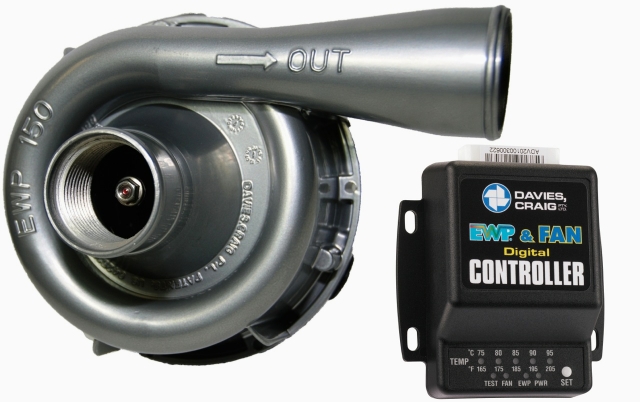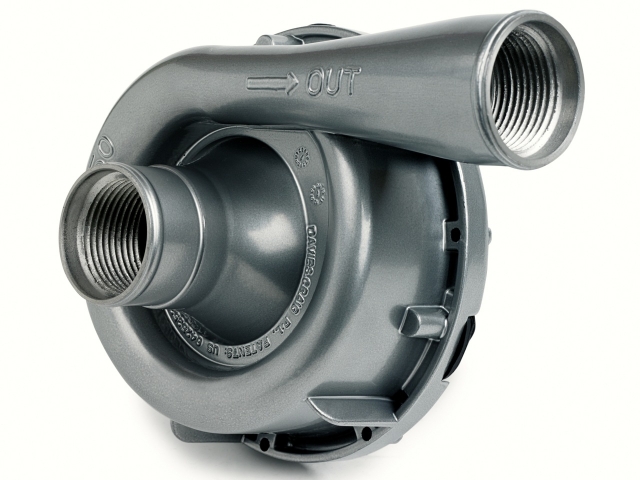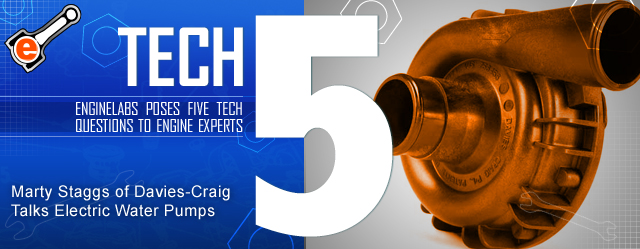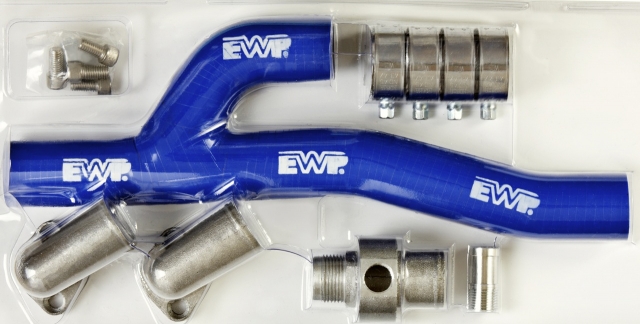TECH5 is a regular feature where EngineLabs [2] asks industry leaders five technical questions. This week’s guest is Marty Staggs, tech specialist with Davies Craig [3].
EngineLabs: What’s a good rule of thumb when selecting a volume rate for an electric pump?
Marty Staggs: Generally, Davies Craig recommends the EWP80 and digital controller (PN#8007) on engines up to 3-litre capacity; the EWP115 & controller (PN#8030 nylon or #8040 alloy) for larger engines; the EWP150 & controller (PN#8060) for higher horsepower/performance engines. EWP pumps fit most engines and mount into the bottom radiator hose. The combo kits are sold complete with the necessary components required for easy installation, along with a DIY instruction booklet.
 [4]EngineLabs: What are the advantages of replacing the thermostat with a digital controller?
[4]EngineLabs: What are the advantages of replacing the thermostat with a digital controller?
Staggs: You should remove the engine’s thermostat – the controller is your new “thermostat.” It allows you to electronically set the engine target temperature. Flow rate will vary according to heat output of the engine and the coolant temp should stay constant. The Thermatic radiator fan should not operate until the EWP is at full speed and the engine temp rises just over the targeted/set temp. When engine temp reduces, the fan should switch off before the EWP speed reduces. You have five (5) temperature options; 70C, 75C, 80C, 85C and 90C for either economy or performance, unlike your thermostat, which is set at one temperature by the engine manufacturer. The controller should be mounted in the driver’s compartment.
EngineLabs: Switching to an electric pump means the stock mechanical pump creates a restriction in the coolant system. What options do engine builders have in removing the old pump?
Staggs: If you want extra power and fuel savings you will need to either: 1) Remove the existing water pump impeller. 2) Disable your existing mechanical belt-driven water pump. 3) Remove the pump entirely and replace it with a suitable block-off plate and an inlet. Alternatively you may wish to keep your existing mechanical pump and use the electric pump as an auxiliary pump. The EWP will power up coolant through the existing mechanical water pump, should this be left in place. For some engines a EWP Header-Adaptor Kit may be available. Consult our website [3] for details.
EngineLabs: How do you determine if you need two pumps (booster pump)? Is it better to mount them in series or parallel?
Staggs: Depending on the volume of coolant required, usually for very high horsepower/performance engines, will determine the requirement to fit two EWPs to an engine’s cooling system. Pumps can be installed either in ‘series’ or in ‘parallel.’ Using the battery example – batteries are described in terms of either series or parallel connections. To acquire 12 volts, two x 6-volt batteries must be connected in ‘series.’ The same two x 6-volt batteries connected in ‘parallel’ produce 6 volts, but the current doubles. Relating these two scenarios to EWP connections to the cooling system of an engine – if we resemble head capacity to voltage, and flow rate resembles current, both types of connections have certain advantages. Two EWPs connected in ‘series’ double the head capacity of a single EWP, while the flow rate remains the same as a single pump. Two EWPs connected in ‘parallel’ double the flow rate capability when compared to a single EWP, while the head capacity remains the same as for a single pump
 [6]EngineLabs: Are there restrictions with regards to types of coolant when using an electric pump?
[6]EngineLabs: Are there restrictions with regards to types of coolant when using an electric pump?
Staggs: Generally no, most glycol-based and other engine coolants are fine. There needs to be serious consideration taken when contemplating using heavy duty waterless coolant. For example, one of these products has a viscosity of 2.3cp @ 100C (212F) and water’s viscosity is 0.347 @ 82.2C. (180F). This is quite a substantial difference and the EWP’s overall performance (flow) may be affected as the waterless coolant will draw more amps and may not allow the EWP to reach the required flow to cool your engine satisfactorily under normal conditions. Two other interesting points; waterless coolant will operate at around 5-8 degrees hotter than conventional water-based coolants. Further, waterless coolant weighs 4.4kg per US gallon and water weighs 3.8kg per US gallon. Bottom line – in our view we don’t believe one is going to achieve the key benefits of efficient coolant flow using a waterless product under these conditions – conventional engine cooling products like water with a water wetter and/or a glycol based additive is a far more economic and cost effective method and a Davies Craig electric water pump will give you a more efficient coolant flow as the EWP’s operation is not directly related to engine revs, rather and more appropriately, engine temperature. In combination with the new EWP/Fan Digital Controller, cooling system control is improved and increases engine power by eliminating parasitic power losses associated with mechanical water pumps.

